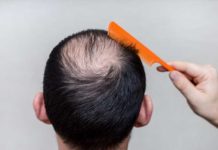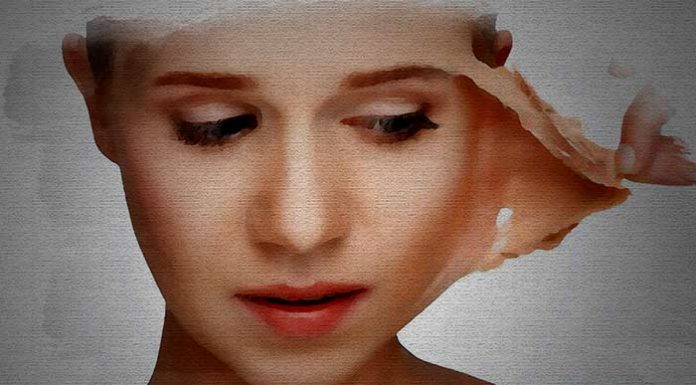
A common misconception prevails that alopecia is another name for baldness. However, alopecia is a medical terminology for any form of hair loss, be it baldness, or hair thinning. Middle English derived the word “alopecia” from a greek terminology alōpekía, which means fox-mange (a skin disease in fox, caused by mites and leading to hair loss). Alopecia is a broader term encompassing several variants of hair loss, and not just confined to any particular form.
Androgenetic alopecia, commonly known as pattern baldness, is the most common form of alopecia, accounting for more than 95% of cases in men and almost 40% in women.
A brief knowledge of the normal biology and development of hair is necessary to understand how one loses hair. Scientifically speaking, hair is thread-like outgrowth of the outermost layer of skin (i.e., epidermis). Hair is composed of a tough protein, known as keratin. The hair visible on the scalp is nothing but dead keratinized cells. Hair is anchored to the skin with the help of a structure, known as hair follicle. Base of the hair follicles is characterized by presence of a hair bulb. These hair bulbs lodge several cells, which actively divide to form hair shaft. The blood vessels provide nourishment to the hair bulb, thus stimulating hair growth. However, hair growth is also regulated by an interaction between several factors, including hormones, immune cells, genes, etc.
We have approximately 1 lac hair on our scalp, which are actively involved in a hair growth cycle, comprising of three phases. These phases are described below.
1. Anagen or Growing Phase: This phase is marked by the most active phase of hair growth, wherein one centimeter to half inch of hair grows in every 28 days. The length of this phase determines the length of your hair. This phase usually lasts for 2 to 7 years. 80% to 90% of hair are at this phase at any given time. With progressing age, the length of this phase decreases, which results in weak and thin hair.
2. Catagen or Transition Phase: This phase marks the end of growing phase. This phase lasts for around 10 to 14 days. About 1 per cent of hair are in this phase at a given time.
3. Telogen or Resting Phase: This phase is characterized by a dormant phase of old hair follicles, which are eventually shed. This phase lasts for about 3 months. 10% to 15% hair are in this phase at a time.
It must be noted that at any given time, every strand of hair is at a different stage of hair growth cycle, which is why we don’t shed or grow our entire load of hair at once. It is a constant process, wherein some strands of hair are growing while some are shedding. It is normal for us to shed 25 to 100 hair per day. However, losing more than this is referred to as alopecia.
Alopecia is caused by a myriad of causes, varying from aging , stress, trauma, genetics and environmental factors to auto-immune diseases, psychological disorders and hormonal imbalances.
Although alopecia is not a fatal condition, it drastically affects an individual’s looks and hence, bears severe psychological implications. However, some forms of alopecia can be effectively managed and reversed through medications and lifestyle changes.
Types
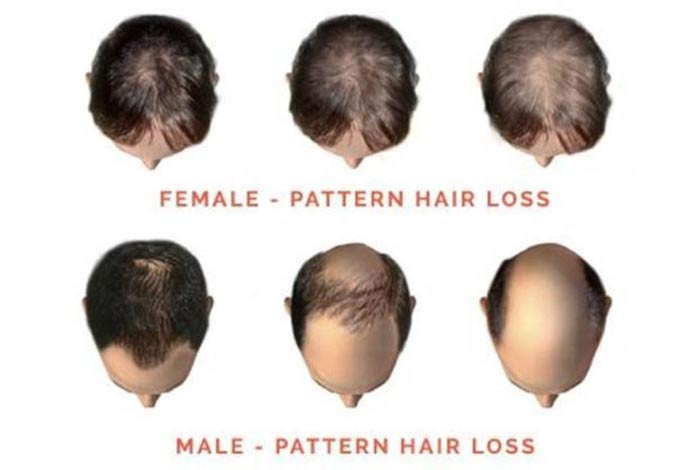
Alopecia is an umbrella term, including several types of hair loss. Various types of alopecia are as follows.
1. Androgenetic alopecia: It is also known as “pattern baldness” and is the most common form of alopecia. As per the U.S. National Library of Medicine, it affects almost 50 million men and around 30 million women in U.S. [1] There are two variants of androgenetic alopecia with characteristic pattern. These are described below.
- Male Pattern Baldness: In men, it can start as early as in teenage and the risk increases with progressing age. More than 50% of men aged above 50 years suffer from this form of alopecia. Male pattern baldness is associated with several other conditions, such as prostate cancer, obesity, diabetes and hypertension (high blood pressure).
- Female Pattern Baldness: In women, it usually develops after menopause. Women suffering from PCOS , experience this form of alopecia, along with acne , weight gain and hirsutism (increased body hair).
2. Telogen Effluvium: It is the second most common form of alopecia, after androgenetic alopecia. As the name suggests, this condition is characterized by increase in number of hair in telogen or resting phase of the growth cycle. In other words, the number of hair in the active growing stage of the growth cycle, severely decline. This results in increased shedding of hair, producing an appearance of generalized hair thinning. The hair shed are typical telogens, with a small keratin bulb at the root end. However, this form of hair loss is not permanent and can be reversed on withdrawing the trigger factor.
3. Alopecia Areata: It is the third most common form of alopecia, with a characteristic round patchy hair loss. It is an autoimmune inflammatory condition, i.e., the immune system becomes hyperactive and recognizes hair follicles as harmful agent and starts acting against them. This form of alopecia can affect men, women and children. But, it is most commonly seen in children aged 5 to 12 years old. 1 in every 1000 children has alopecia areata.
However, children affected by the condition before puberty, are at a higher risk of developing a more severe and persisting hair loss later. Based on the affected area of the body and the extent of involvement, American Hair Loss Association lists down following types of Alopecia Areata.[2]
- Alopecia Totalis: This form of Alopecia Areata involves the entire scalp.
- Alopecia Universalis: If the hair loss is seen involving the entire body, including scalp, eyelashes, eyebrows, beard, pubic hair, etc., it is referred to as Alopecia Universalis.
- Alopecia Barbae: If Alopecia Areata is confined to the beard area in men, it is known as Alopecia Barbae.
Although Alopecia Areata causes an autoimmune destruction of hair follicles, the hair re-grows once the inflammation subsides.
4. Scarring Alopecia: It is also known as cicatrical alopecia, and is a collection of disorders of hair loss, including eosinophilic pustular folliculitis, dissecting cellulitis, follicular decalvans, follicular degeneration syndrome (formerly known as “hot comb” alopecia), lichen planopilaris, etc. These are seen in 3% of hair loss patients. It usually causes an irreversible destruction of hair follicles, with their replacement with scar tissue. It begins as a patchy hair loss. However, unlike alopecia areata, the bald patch in scrarring alopecia has more ragged edges. This form of alopecia is permanent and the hair may never grow back.
5. Anagen Effluvium: It is a diffuse hair loss involving the entire body, caused due to some medications or treatment. The presentation of traction alopecia, depends on the way hair are being pulled. The hair strands shed are typical anogen stage hair strands with tapered or feathered root ends. Unlike telogen effluvium, this form of alopecia is more sudden and causes a drastic amount of hair loss. However, it is a temporary condition, which resolves on cessation of the respective causative factor.
6. Traction Alopecia: This type of hair loss occurs due to increased tension or traction in the hair shaft, caused by certain hairstyles. Although it is usually reversible, prolonged traction can cause irreversible damage to the hair follicles.
7. Trichotillomania: It is an impulse-controlled disorder, which shares its symptoms with OCD. It is usually seen in children, characterized by a habit of pulling out one’s hair. As per an estimate, it occurs more frequently in women and affects 1% to 2% of adults and adolescents.[3] It can involve any area of the body, but commonly involves scalp, eyelids and eyebrows. In some individuals. It is a reversible condition, while in others it may be permanent.
8. Involutional Alopecia: This refers to age-related thinning of hair and is one of the significant signs of aging. With progressing age, most of the hair gets arrested in the resting phase, and the length of telogen phase shortens, thus leading to a generalized thinning of hair.
Symptoms

The clinical presentation of alopecia varies with the type of alopecia. These are described below.
1. M-shaped pattern of hair loss: This is a typical presentation of a male pattern baldness. Male pattern baldness begins on the temple region (side of head). With time, it causes receding of the hairline, thus producing a characteristic M- shaped pattern. It also causes thinning of hair at the crown region (top of the head), eventually leading to a partial or complete baldness.
2. Thinning of hair: The pattern of hair thinning varies with the type of alopecia. A generalized thinning of hair, without a receding hairline is a classic feature of female pattern baldness. A thinning of hair seen in Telogen Effluvium usually has an uneven pattern, with a more marked thinning at the top of the head, as compared to sides and back of the scalp.
3. Patchy hair loss with or without remission periods: Patchy hair loss is a major feature of alopecia areata, wherein either a single bald patch or an extensive patchy hair loss is seen. However, in alopecia areata, there are remission periods when the hair re-grows but, falls out again. A patchy hair loss may also mark the beginning of a scarring alopecia.
4. Gradual Hair loss: Some individuals may lose hair gradually and not suddenly. It may sometimes be seen in scarring alopecia. This feature may render the condition unnoticeable in the initial stage.
5. Pain, itching and burning of scalp: Some patients of scarring alopecia may develop pain, itching and burning of scalp, along with hair loss.
6. Hair loss from other parts of body: Some forms of alopecia may present as hair loss from parts, other than the head. It may be seen affecting just beard (alopecia barbae) or entire body (anagen effluvium).
7. Psychological symptoms: Patients of trichotillomania, present with a feeling of loss of control, shame or embarrassment, and keep pulling their hair, leading to severe hair loss.
Risk Factors

1. Age: As already discussed in involutional alopecia, progressing age increases the risk of developing alopecia. Hence, it is not uncommon to see alopecia in individuals aged 50 and above.
2. Genetics: Alopecia runs in family. This is particularly true in case of androgenetic alopecia.
3. Illnesses or diseases: Prolonged illness like a high fever or a severe infection puts a person at a higher risk of developing alopecia. Diseases such as hypothyroidism, hyperthyroidism, lupus, tinea capitis (ringworm of the scalp), diabetes, etc. also increase the risk of alopecia.
4. Medications and Treatment therapy: Certain medications, including anti-cancer drugs, birth control pills, etc. and some treatment procedures like radiation therapy and major surgery, increase the risk of developing alopecia.
5. Hair styling: Certain hair styles, producing excessive tension in the hair, increases the risk of developing traction alopecia in the long run. Excessive hair shampooing and brushing also increases the risk of losing hair. Braiding, hair weaving, excessive heat exposure to scalp and temporary or permanent hair straightening drastically increases the risk of alopecia.
6. Stress: Stress has been implicated as a major risk factor of hair loss, in people of any age and gender. A stressful childhood may also manifest as a psychological disorder in adulthood or adolescence. One significant example is trichotillomania.
7. Nutrition: A diet, deficient in some key vitamins and nutrients, also increases the risk of developing alopecia.
Do I have it?
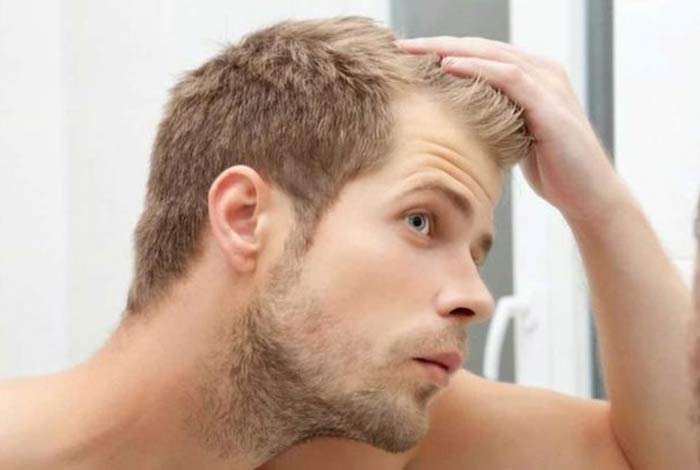
If you are losing hair, more than the normal rate (< 150 hairs/ day), you may have alopecia and you must seek medical help to determine an effective course of action.
If you have a genetic history of alopecia, you are at a very high risk of developing it too. If you have developed a bald patch, or have lost hair from your beard, or have been experiencing thinning of hair, you are definitely suffering from alopecia.
If you are a male with a genetic history of alopecia and have been losing hair from the crown part of your scalp, you are likely to develop a M-shaped pattern, typically seen in male pattern baldness.
If you are a female and have developed a generalized thinning of hair along with weight gain or weight loss, you are more likely suffering from hypothyroidism or hyperthyroidism. However, if the hair thinning and weight gain has accompanied acne and increased body hair, it raises a strong suspicion of alopecia related to PCOS.
Causes
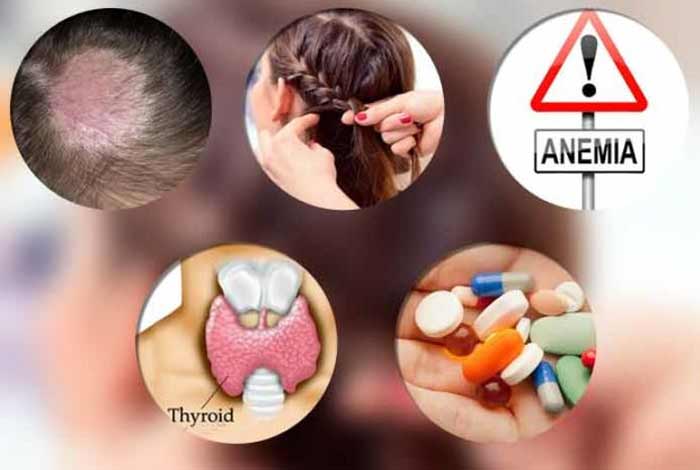
Several causes can be attributed to alopecia. These are described below.
1. Heredity: Heredity is the most common cause of hair loss, which is seen as a male or female pattern baldness. The genetics of female pattern baldness is not completely known yet. However, the genetics of male pattern baldness has been a subject of interest for the researchers. Although baldness gene is seen linked to X-chromosome, both maternal and paternal genes play a role in baldness, with a slight dominance of maternal genes. So, a male inherits baldness from both mother and father. Heredity also determines the age on onset of baldness, the rate of losing hair and the extent of baldness.
However, it must be noted that genetics alone may not be the causative factor. Baldness occurs due to an interplay of genes, environmental factors and several other factors.
2. Hormonal Changes: Several hormones can be held responsible for causing hair loss. These are as follows.
- Testosterone: One major hormone is testosterone, which is present in optimal amounts in men and in minimal amounts in women. An increased level of testosterone, can lead to an elevated Dihydrotestosterone (DHT), which is a by-product of testosterone breakdown. DHT can cause pattern baldness in both males and females. Increase in androgen level in women is suggestive of PCOS. Also, some people have an inherited hypersensitivity to DHT, hence are more susceptible to develop alopecia.
- Thyroxine: It is a vital hormone, secreted by the thyroid gland. Thyroxine plays a key role in metabolism. An overproduction (hyperthyroidism) or an underproduction (hypothyroidism) of thyroxine, can both lead to alopecia.
- Estrogen: A balanced estrogen level in women, is necessary to stabilize mood, maintain a healthy sex drive and is also vital to maintain the health of hair. Weight gain, pregnancy, menopause and certain medications, can cause estrogen imbalance, thus causing alopecia in women.
- Insulin: It is released by beta cells of pancreas and is required for maintaining the overall health of an individual, including the health of hair. Insulin resistance (i.e., diabetes) can also lead to alopecia.
- Coritsol: This hormone plays an important role in “fight or flight” response of the body, to stressful situations. However, an increased cortisol production can hamper the health of the bones and muscles and can also impair the cell regenerative capacity of the body. Thus, an elevated cortisol level can lead to alopecia.
3. Auto-immune diseases: Autoimmune diseases, refer to a collection of disorders, in which the body’s immune system attacks its own cells and tissues, thus producing various symptoms. When the body immune cells act against the hair follicles, it can lead to a particular variant of alopecia, known as alopecia areata. Various diseases that lie in this category are lupus, Hashimoto’s thyroiditis, vitiligo, ulcerative colitis and rheumatoid arthritis.
4. Scalp Infections: Certain fungal infections of the scalp, such as tinea capitis (ringworm of scalp) can cause scaling of scalp and loss of hair. However, once the infection resolves, hair re-grows.
5. Skin conditions: Certain conditions of the skin can also cause alopecia, such as boils, sunburns, seborrheic dermatitis, scleroderma, lupus, psoriasis, lichen planus, etc. These conditions lead to scarring alopecia.
6. Nutritional deficiencies: Deficiency of vitamins and iron can lead to hair loss. Hence, it is not uncommon to see hair loss in patients of anemia. Also, eating disorders, like anorexia or bulimia can cause hair loss.
7. Psychological Disorders: A particular psychological disorder, known as trichotillomania, is also a major cause of alopecia (as already discussed in “types of alopecia”).
8. Medications: Alopecia can occur as a side-effect of some medications, as listed below.
- Anti-cancer drugs (chemotherapy)
- Birth control pills
- Blood thinners (medically termed as anticoagulants), like heparin, warfarin, etc. usually given to prevent Deep vein thrombosis or pulmonary embolism
- Medicines for arthritis, like indomethacin
- Drugs for gouts, such as colchicine and allopurinol
- Drugs for bipolar disorder, like lithium
- Consumption of Vitamin A in high doses
- Drugs for epilepsy, like carbamazepine, valproic acid, etc.
- Vaccinations, especially Hepatitis-B vaccine
- Drugs for hypertension, like beta-blockers.
- Amphetamines, such as methamphetamine or dextroamphetamine
9. Radiation therapy: Exposure of scalp to radiation can also lead to alopecia. Radiotherapy forms an integral component of cancer treatment.
10. Stress: Physical or mental stress, act as a major trigger factor for alopecia. Various stressful events, such as surgery, high fever, sudden excessive weight loss or a recent mishap, can lead to hair loss. However, termination of the trigger factor can reverse the process and hair can re-grow.
11. Certain hair treatments and hair styling: Recurrent hot oil treatment of hair, getting hair permanents and other chemical or heat treatment of hair can cause alopecia. Certain styles of hair, including cornrows or pigtails, can lead to traction alopecia. Usually the hair can re-grow. However, if scarring has occurred, the hair loss is permanent.
Prevention

Most forms of alopecia cannot be prevented, such as genetically acquired alopecia, age-related alopecia or alopecia due to chemotherapy or radiotherapy. However, it can be delayed. Certain measures which can be taken to prevent and delay the onset of hair loss are as follows.
1. Have a nutritious diet: As already stated, nutritional deficiencies can cause alopecia. Thus, having a diet rich in vitamins and iron can play a vital role in combating alopecia.
2. Avoid certain hair-styles: As already mentioned, some hair-styles like braids, buns or ponytails can cause traction alopecia. Hence, refrain from these hair-styles on a regular basis.
3. Avoid trauma to the hair-shaft: Compulsive twisting, pulling or rubbing of hair can cause damage to the hair shaft, thus leading to hair loss. Also, improper handling of hair while washing or combing can also lead to hair loss. Hence, such deleterious actions should be avoided. Use a wide-toothed comb to prevent alopecia.
4. Avoid excessive heat and chemical treatment: Curling irons, permanents, hot oil treatment and hot rollers can damage the hair. Hence, these must be avoided.
5. Lead a stress-free life: Since, stress is one of the major cause of alopecia, managing stress through yoga, meditations and other methods, is essential.
6. Seek medical help at the earliest stage: If you have been experiencing hair loss, seek medical help at the earliest. Recognizing the cause of alopecia after thorough medical evaluation is vital to prevent it from progressing to a severe state.
Diagnosis
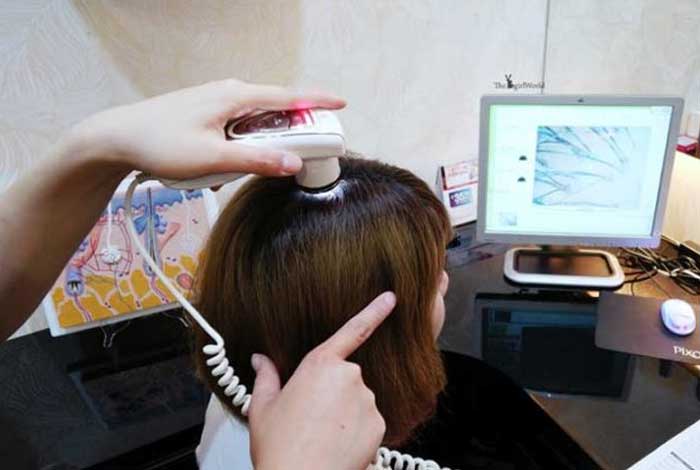
Alopecia presents itself with prominent features, hence is easier to diagnose. However, knowing the underlying cause requires medical expertise. Therefore, it is necessary to seek consultation from a skin specialist (i.e., dermatologist). Various methods of diagnosis of alopecia are described below.
1. History of symptoms: Your doctor may ask you details regarding your symptoms, such as the symptoms you have been experiencing, since how long have you been losing hair, did it appear suddenly, any associated weight loss or gain, any habit of pulling hair (suggestive of trichotillomania), any presentation on skin (such as acne) and other symptoms like itching, redness and pain in scalp. Getting thorough history of symptoms facilitates in an accurate diagnosis.
2. Medical History: Since hair loss has a strong association with medical conditions, your doctor may seek your medical history, including diabetes, hypertension, lupus, PCOS, etc. This aids in determining the underlying cause of alopecia.
3. Treatment History: As already stated, some treatment procedures and medications may lead to an accelerated hair loss. Your doctor may ask you if you have undergone such treatment or are still on any medication (list of alopecia-causing drugs mentioned in “causes” section). Your doctor may also ask you about any recent surgery as a surgical procedure may inflict physical stress, leading to hair loss.
4. Pregnancy and Menstrual History: A recent delivery or pregnancy can also cause hair loss due to hormonal changes. Thus, your doctor may seek details of your pregnancy history. Your doctor may also ask you about your menstrual history, which may be indicative of menopause or other hormonal imbalances.
5. Family History: Genetics play a significant role in alopecia. Hence, your doctor may seek information about presence of baldness or any other form of alopecia in your family, including both maternal and paternal relatives.
6. Physical Examination: After taking a thorough history, your doctor may examine your scalp and skin to determine the pattern of alopecia and locate the exact cause of alopecia. Your doctor may look for signs of diseases like fungal infection and may look for signs of skin diseases like lichen, psoriasis, scleroderma, etc.
7. Diagnostic Tests: Once doctor has examined your scalp and skin, some diagnostic tests may be ordered to reach a definitive diagnosis. These tests are described below.
- Blood tests: Your doctor may order some blood tests, regarding hormonal assays, hemoglobin levels, etc. This may be done to rule out thyroid diseases, anemia, etc.
- Pull Test: In this test, your doctor pulls out several strands of hair, to see how may fall out in one pull. This aids in determining the stage of hair fall.
- Scalp biopsy: In this procedure, a small sample of skin or affected scalp is excised and is sent to laboratory for examination. Scalp biopsy is rarely performed.
- Dermoscopy: This procedure involves microscopic examination of the hair and scalp. Presence of yellow spots in the areas of hair loss is suggestive of alopecia areata.
Treatment
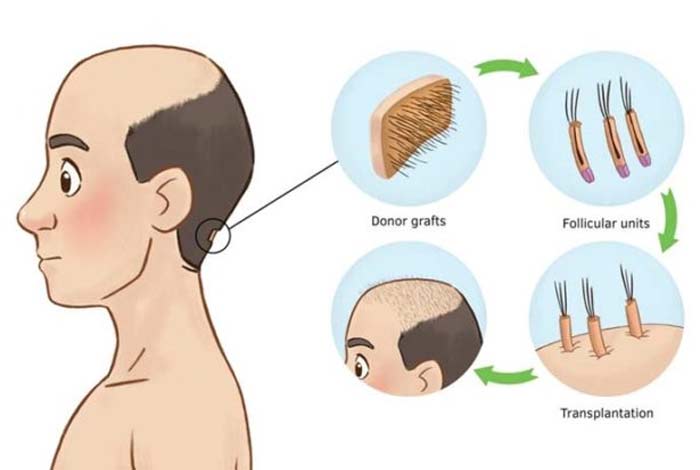
Some variants of alopecia are permanent and offer a minimal chance of hair re-growth. However, other variants may show hair re-growth with the treatment modalities.
The aim of treatment of alopecia include arresting the hair loss, promoting hair re-growth and concealing the affected scalp area.
Various treatment modalities of alopecia are described below.
1. Medications: The drugs used in alopecia depend on the underlying cause. Various drugs used in the treatment of alopecia are described below.
- 5-alpha reductase inhibitors, including finasteride and dutasteride
- Androgen independent hair growth stimulator, including minoxidil
- Androgen receptor inhibitor, including spironolactone and cyproterone acetate
- Antihistamine, such as cimetidine
- Corticosteroids, in oral, injectable and topical form
- Antipsoriatic agent, like Anthralin
- Antibiotics, such as sulfasalazine
- Topical Immunotherapy, like cyclosporine, methoxsalen, etc.
- Oral contraceptives
- Antifungals, like ketoconazole, fluconazole
2. Surgery: In advanced case of alopecia, wherein hair loss is permanent and chance of hair-regrowth is negligible, various surgical procedures may be advocated. These are described below.
- Hair transplantation: In this procedure, the hair follicles from the hair-bearing and baldness-resistant part of the scalp (such as back of the head), are removed and placed over the part of scalp with dead hair follicles.
- Scalp reduction surgery: In this procedure, the part of scalp with no hair is removed. This is followed by joining the hair-bearing areas of the scalp together. This treatment procedure can be performed alone, or in combination with hair transplant.
- Scalp expansion: As the name implies, this procedure involves expanding the hair-bearing areas of the scalp with the aid of a device inserted underneath the scalp, in a period of 3 to 4 weeks. This minimizes the balding. It may also be used to improve the laxity of the scalp, which is then followed by scalp reduction. This may also be performed along with hair transplantation.
- Scalp flaps: In this procedure, the part of the scalp with abundant hair and which is less likely to undergo baldness, is removed and placed over the bald patch, with dead follicles.
3. Wigs and Hairpieces: Some forms of alopecia show a poor prognosis, i.e., the chances of hair re-growth are close to impossible. In such cases, the social and psychological implication of alopecia may be lessened with the use of natural-looking wigs and hairpieces.
4. Photochemotherapy: This procedure involves use of phototherapy after chemotherapy. Phototherapy is based on targeting ultraviolet radiation to the affected area, with the aid of machinery. Research has shown that targeted UVA phototherapy after topical application of 8-methoxypsoralen (8-MOP).[4]
Care

Alopecia can be socially and psychologically overwhelming for the person to deal with. Also, it may indicate a severe underlying cause. Hence, it is imperative for family, friends and peer to encourage such patients to seek medical help.
Also, patients undergoing chemotherapy may find it even more tormenting to lose hair. At this critical time, support from close ones can ease up the struggle.
If you suspect your close one to be dealing with some psychological distress either due to day-to-day struggle or due to a recent mishap, you must provide them adequate emotional support.
People with a habit of pulling hair, must be encouraged to seek medical help.
The social dogma associated with alopecia can make it difficult for individuals to make it through their day. Hence, people suffering from alopecia should not be looked down upon.
OTC
Among the various medications used in the treatment of alopecia, cimetidine and minoxidil are available as over-the-counter drug in most countries. People with nutritional deficiencies, may also easily get vitamin and iron supplements over-the-counter. However, other drugs would require prescription by a doctor.
Self-Management Methods Available

Inherited baldness would usually require medical intervention. However, certain self-management methods can complement the positive effects of medications and other therapies.
- Manage stress: Stress is a major causative factor of alopecia. Hence, managing stress is vital to combat hair loss. It can be done through various means, such as yoga, meditation and other alternative methods.
- Eat balanced diet: A nutritious diet is necessary to maintain the health of hair. Hence, eating a protein and vitamin-rich food with everything else in moderation is important to counteract hair loss.
Natural Ways to Cure

Although medical intervention is essential to counteract alopecia, there are several natural at-home remedies to cure alopecia. These are described below.
1. Probiotics: These are compounds, which augment the growth of healthy bacteria in the gut. The health of gut has been directly linked to immune system. Research has shown that consumption of probiotics, such as apple cider vinegar, yogurt, cultured vegetables, etc. can boost immunity and arrest the hair loss.
2. Zinc: A recent study, published in the International Journal of Dermatology, serum of alopecia patients demonstrated lower zinc levels. Hence, zinc deficiency has been linked with alopecia. Therefore, consumption of diet rich in zinc, such as chickpeas, spinach, pumpkin-seeds, etc. may help in treating alopecia.[5]
3. Quercetin: It is a flavonoid antioxidant, known to combat free radical damage and alleviate inflammation. A recent study has shown that quercetin may prove effective in alopecia.[6]
4. Ginseng: Another study recommends the use of red ginseng as a complementary food in the treatment of alopecia, in particular alopecia areata.[7]
5. Aromatherapy: Research has shown that aromatherapy is effective in alopecia, due to its anti-oxidant and anti-inflammatory properties. This study involved use of essential oils, like thyme, cedarwood, lavender and rosemary.[8]
6. Acupuncture: It involves insertion of thin needles in the body. Acupuncture stimulate hair follicles, reduce inflammation and relieve anxiety and depression, thus proving effective in alopecia.
7. Reduce stress: Relieving stress can prove highly beneficial in alopecia. Activities like yoga, meditation and even a long walk can stimulate the hair follicles, improve circulation and relieve stress.
Health Tip by Experts
Looking down upon those suffering from alopecia is a common social practice. Remember that beauty is not defined by presence or absence of hair. Staying happy and healthy should be the motto.

